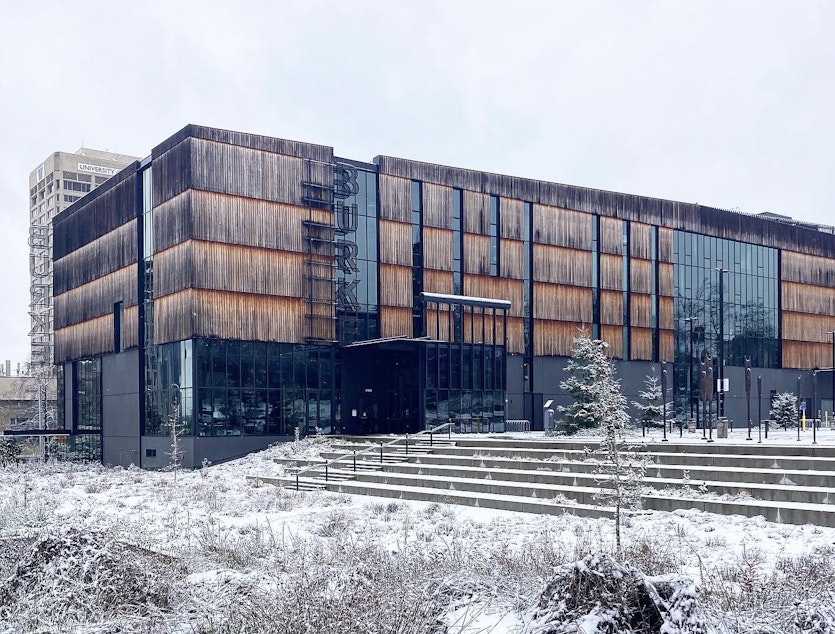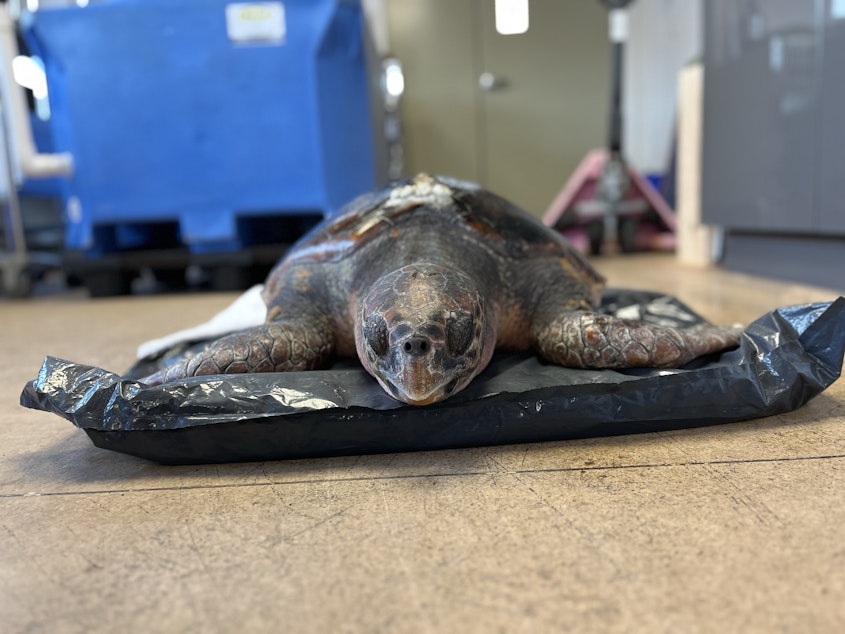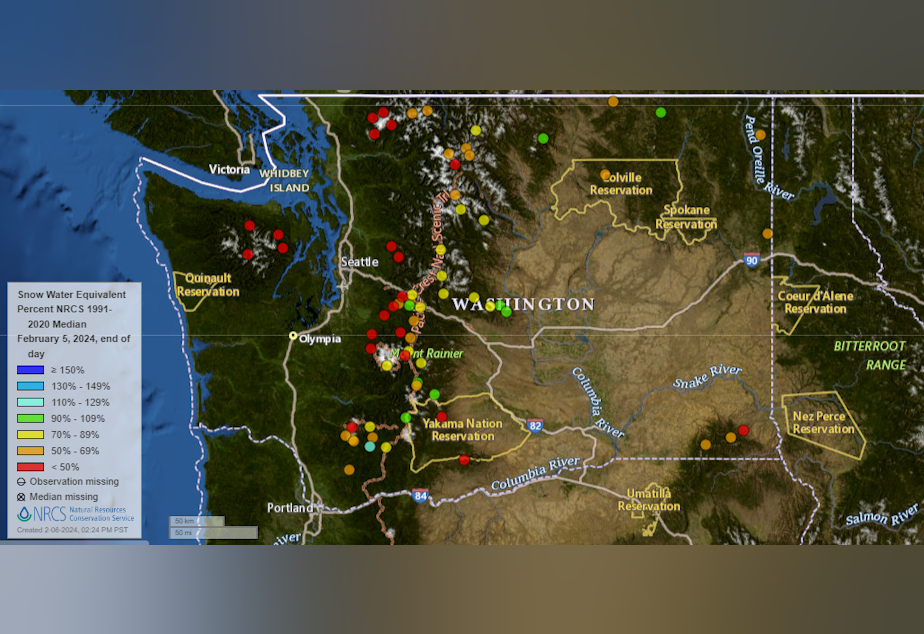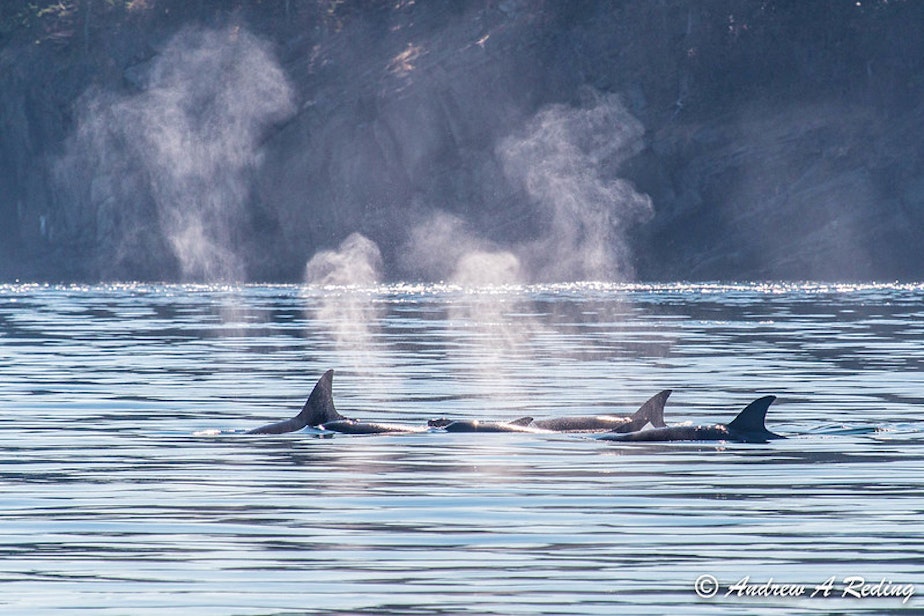

KUOW Blog
News, factoids, and insights from KUOW's newsroom. And maybe some peeks behind the scenes. Check back daily for updates.
Have any leads or feedback for the KUOW Blog? Contact Dyer Oxley at dyer@kuow.org.
Stories
-
Both hands on the wheel, Washington drivers. Your insurance rates are about to jump 24%
Government

Washington drivers may see an increase in vehicle insurance costs by an average of 24%, the biggest bump in a long time. This comes on the heels of a relatively tame period for rates over the last five years.
The Office of the Insurance Commissioner – the regulating body for the insurance industry in Washington state – approved a 2023 rate increase average of 24% for car insurance companies.
“We saw a 2.8% increase in 2022,” said Aaron VanTuyl, communications manager for the insurance commissioner. “No increase the year before that, and then 2020 there was actually a 3% decrease.”
VanTuyl added that consumers could look at this information and say insurers are just catching up on things.
He said the reason for the approved rate increase is because insurance companies have reported an increase in serious bodily injury and fatal auto accident claims over the years.
“The biggest factor we've seen is that there have been more severe accidents the last few years,” VanTuyl said.
More severe accidents have led to larger payouts. Another factor impacting rates is the cost of buying and repairing cars.
VanTuyl shared that the Office of the Insurance Commissioner has a new rule going into effect in June 2024. Upon request, insurance carriers will have to give consumers an explanation as to why their insurance rates have increased – in terms they can reasonably understand.
In 2027 carriers will have to provide this notice, even if a consumer doesn’t ask. The goal is to make things easier for consumers and require carriers to be more transparent with policyholders.
Continue reading » -
UW's Burke Museum working with Native tribes to repatriate tribal objects
Government
 The Burke Museum on Dec. 20, 2022, at the University of Washington in Seattle.KUOW Photo/Katie Campbell
The Burke Museum on Dec. 20, 2022, at the University of Washington in Seattle.KUOW Photo/Katie CampbellMuseums across Washington state may no longer display some Native artifacts without permission under a new federal rule.
The nationwide rule, which took effect in January, bars museums from displaying or doing research on sacred objects without consent from their tribes of origin — the sort of things looted from Native gravesites.
Some museums, like the American Museum of Natural History in New York, closed entire halls in response.
RELATED: Repatriation celebration as stolen Native Hawaiian remains stop in Sea-Tac on their way home
At the University of Washington’s Burke Museum in Seattle, Justice McNeeley’s job is to return items tribes want back. McNeeley said the Burke has long worked with tribes to ensure that its displays are appropriate, and its exhibits will remain open for now.
“We, of course, are going to continue consultation with tribes to ensure that we are still up to date with everything that we have on display and making sure that we are taking proper care," McNeeley said.
Burke officials said the new rules may speed up the process of repatriating tribal objects. Curator Sara Gonzalez said she hopes it will make it easier for tribes to reclaim artifacts they want returned.
"At current rates, it would take over 200 years — those are best estimates — to actually complete the work of repatriation," Gonzalez said. "I am hopeful that it will help speed up the process and ensure that we've taken care of this work sooner rather than in several generations from now."
RELATED: The lasting effect indigenous boarding schools have had on Washington state
That was the Biden administration's goal: to speed up repatriation.
According to The New York Times, those government efforts date back to 1990 with the passage of the Native American Graves Protection and Repatriation Act, or NAGPRA. The Act established rules for museums and other institutions to return human remains, funerary objects, and other items to tribes.
Continue reading » -
Does playing soccer on artificial turf increase cancer risk, especially in kids?
Environment
 Seattle Reign Academy players practice on Monday, January 29, 2024, at North SeaTac Park.KUOW Photo/Megan Farmer
Seattle Reign Academy players practice on Monday, January 29, 2024, at North SeaTac Park.KUOW Photo/Megan FarmerLongtime University of Washington goalies coach Amy Griffin is not an activist by nature. But 15 years ago, she identified what she believed was a trend that she couldn’t ignore in good conscience — young goalies being diagnosed with blood cancer.
It started when she ran into two of her former goalkeepers at University Village, an outdoor mall in northeast Seattle. The two young women had grown up playing soccer in the same Seattle neighborhoods, on the same fields. When Griffin saw them at University Village, they had another thing in common: Both were bald from undergoing chemotherapy treatment for lymphoma.
After working with goalkeepers for decades (and playing in goal for the U.S. Women’s National Team), Griffin recognizes certain personality traits particular to goalies. Being a goaltender, especially at a high level, requires relentless optimism in the face of inevitable heartache: You can make spectacular saves, but it’s the one mistake people remember.
That day at University Village, Griffin saw that goalie attitude — unrelenting optimism and a sense of common fate — in her two former players. They saw their diagnoses as an ironic twist that was related somehow to their role on the field. Typical goalkeepers, they said, shaking their heads and smiling.
But also, “Why us?”
“One of them said, ‘I wonder if it's the stuff in the field,” Griffin recalled. “I wonder if it’s those little black dots, because we're eating them, we get them in our eyes, we get them in our abrasions.”
Those little black dots are the crumb rubber used as infill on more than 13,000 playing and practice fields across the U.S. Each of those fields uses 20,000 to 40,000 shredded waste tires to provide cushioning and traction. While waste tires are heavily regulated because they contain known carcinogens and heavy metals, when those same tires are chopped up and put on playing fields, they are unregulated.
For more than a decade, parents, coaches, and players have worried that the crushed-up tires pose health risks. Studies to date, both in the U.S. and Europe, have revealed extensive toxic chemicals within crumb rubber, but most conclude the level of exposure people have when playing or practicing on artificial turf is too low to put them in danger.
Meanwhile, Griffin’s list of former goalies and other athletes with cancer continues to grow. The list now includes close to 300 people, more than half of whom have a form of blood cancer.
Continue reading » -
WA Rep. Cathy McMorris Rodgers won't run for re-election
Politics
 McMorris Rodgers speaking at the 2015 Conservative Political Action Conference (CPAC) in Washington, D.C.Wikimedia/Gage Skidmore
McMorris Rodgers speaking at the 2015 Conservative Political Action Conference (CPAC) in Washington, D.C.Wikimedia/Gage SkidmoreU.S. Rep. Cathy McMorris Rodgers (R-Spokane) announced Thursday that she will not seek re-election.
"It's been the honor and privilege of my life to represent the people of Eastern Washington in Congress," McMorris Rodgers said in a statement. "After much prayer and reflection, I’ve decided the time has come to serve them in new ways."
McMorris Rodgers has represented Washington's 5th Congressional District since 2005. Her seat is up for re-election this year. She's also currently chair of the House Energy and Commerce Committee.
RELATED: McMorris Rodgers hopes to reset energy policy, if she heads House energy committee
Her statement did not indicate what McMorris Rodgers will do next, ending instead on a vague assurance that "the best is yet to come."
But Jordan Evich, a Republican political consultant, told KUOW he believes she has no plans to run for higher office, and is likely to take a job outside of politics.
That's at least in part because of the current dynamics in the House.
Evich said McMorris Rodgers wants to get legislation passed, and that's not happening much these days.
"When you are someone who wants to get something done, it's hard to do that in an increasingly gridlocked environment," he said.
Just this week, former President Donald Trump reportedly helped kill a bipartisan immigration deal that had been championed by leading Republicans in Congress.
McMorris Rodgers is the second member of Washington's congressional delegation to step aside ahead of the 2024 election. U.S. Rep. Derek Kilmer (D-Gig Harbor) announced in November he would not seek re-election in Washington's 6th Congressional District.
According to McMorris Rodgers' office, she was the 200th woman elected to serve in the U.S. House of Representatives and the first woman to give birth three times while in office.
She's been in the House through some tumultuous times.
Just last year, eight hardline Republicans joined Democrats to oust former Speaker Kevin McCarthy from his job. While all eight of Washington's Congressional Democrats voted to remove McCarthy, McMorris Rodgers and her fellow Washington Republican Rep. Dan Newhouse voted to keep him.
RELATED: Are Washington state Republicans fully behind former President Trump?
McMorris Rodgers also was in the House for both impeachment votes against former President Donald Trump in 2019 and 2021. She voted against impeachment both times.
In January, a supermajority of Republicans in Congress signed an amicus brief to support Trump's place on Colorado's presidential primary ballot. McMorris Rodgers was among them.
"No matter the division, we must unite in prayer," McMorris Rodgers said in her statement Thursday. "And as we do, we will bring hope and healing to broken lives, broken families, and broken systems failing broken people."
Several Democrats have already entered the race in her district.
The Spokesman-Review reported in November that Carmela Conroy, chair of the Spokane County Democrats, and small business owner Ann Marie Danimus were running. The paper also reported Bernadine “Bernie” Bank, an OB-GYN, was considering jumping into the race.
Danimus pointedly acknowledged McMorris Rodgers' exit from the race on X, formerly known as Twitter, writing, "Things just got interesting in the 5th CD."
KUOW's David Hyde contributed to this report.
Continue reading » -
Seattle brewery crafts Chinese culture in every drop of this Lunar New Year beer
Arts & Life
 Raymond Kwan, left, and Barry Chan pose in front of the mural of Chinese Zodiac animals outside Lucky Envelope Brewery in Seattle's Ballard neighborhood. Every Chinese Lunar New Year, their brewery crafts beer for the occasion (dragon, rooster, rabbit, etc.). It's one way they include their Chinese heritage in their work.KUOW Photo / Clare McGrane
Raymond Kwan, left, and Barry Chan pose in front of the mural of Chinese Zodiac animals outside Lucky Envelope Brewery in Seattle's Ballard neighborhood. Every Chinese Lunar New Year, their brewery crafts beer for the occasion (dragon, rooster, rabbit, etc.). It's one way they include their Chinese heritage in their work.KUOW Photo / Clare McGraneLunar New Year holds special meaning for various cultures throughout Asia, and also throughout Washington state. At Seattle’s Lucky Envelope Brewing, it’s about Chinese culture, it’s about family and community, and importantly, it’s about beer.
Where else are you going to find beer made with dragon fruit or Sichuan peppercorns?
“The whole point of a lot of the major holidays in Chinese culture is to bring people together, particularly family and friends,” said Raymond Kwan, co-founder of Lucky Envelope Brewing. “And aside from your red lanterns and your lucky envelopes, it's about food and drink.”
RELATED: Will Lunar New Year become a state-recognized holiday in Washington?
Lunar New Year 2024 will bring a suite of new beers at the brewery — all special blends celebrating the holiday that begins on February 10, the start of the Wood Dragon year on the Chinese lunar calendar.
The holiday is a major celebration in many cultures across East Asia, notably China, Japan, Vietnam, and the Philippines. Lucky Envelope founders Kwan and Barry Chan are among the roughly 740,000 Washingtonians who have heritage in countries that celebrate Lunar New Year. That pencils out to nearly 10% of the state’s population. It’s so culturally significant, there is an effort in the state Legislature to recognize the holiday.
Kwan and Chen celebrate Lunar New Year by bringing people together around their brewery. This year, they shut the taproom down early to host a Lunar New Year dinner for its staff, introducing many to new foods and traditions central to the holiday. The brewery also partners with others in Seattle’s Asian-American community to host special events.
Through their beer, Kwan and Chan emphasize the importance of bringing people together. They grew up in Chinese-American households. That meant piling into homes with dozens of family members and friends to celebrate Lunar New Year. In the west, it’s akin to family Christmas gatherings.
RELATED: Craft nonalcoholic scene is brewing in Seattle, just don't call it a 'mocktail'
Each year, older generations in the family hand out red paper envelopes containing money. It’s a stand-out memory from these childhood celebrations. Today, this tradition is Lucky Envelope’s namesake.
“The color red is meant to ward off evil spirits and the money inside is supposed to bring prosperity to the person receiving it,” Kwan explained. “It was exciting to kind of tie in our cultural heritage into the name of the brewery.”
“What’s really awesome about the craft beer community is it’s really a community that revolves around drink … the correlations we see between the craft beer industry and Chinese culture — bringing people together in a community setting to share a beverage, and cheers, and share stories, and have fun. It makes everything about what we’re doing with the brewery, how we’re engaging the community, and supporting the community, much more fun.”
2024 Lunar New Year beer
Lucky Envelope Brewing’s Ballard taphouse is generally full to the brim (literally) with eclectic flavors. A stout blended with peanut butter and coffee. A sour beer featuring pureed pineapple, passionfruit, and lemon. A hard seltzer mimicking the soda cult classic Baja Blast. Each Lunar New Year adds a few more flavors to the brewery’s palate.
Continue reading » -
'Work hard to get ahead,' Seattle Boomers say. 'Extra work, extra pay,' Gen Z says
Arts & Life
 Working from home.
Working from home.The concept of a work/life balance "was not a thing" for most of Baby Boomer Eileen's career. You worked, and then you worked even harder to get ahead.
Fast forward a few generations and you come to 22-year-old Jade, a member of Gen Z.
"I refuse to, most times, even check my email when I’m not on the clock, definitely won’t respond to anything … there is a true boundary between my work and my personal life, and I never really let those bleed into each other," Jade told KUOW.
Both are workers in Seattle, but work quite differently. Why?
RELATED: Still grappling with staff shortages, Seattle area restaurants get creative
There's a generational gap among the workforce. Employers are trying to understand this gap amid an ongoing national worker shortage. Millennials are now the largest group in the workforce, with Gen Z coming on the job more and more each day.
In the latest episode of "Booming," a podcast about Seattle's growing pains, KUOW's Monica Nickelsburg endeavors to answer: Why does Gen Z, and some Millennials, have a reputation for being difficult to work with (if they're working at all), and why they're less inclined to go above and beyond at work?
The answer may not be what you assume.
Continue reading » -
Warm-water turtle rescued from Salish Sea after fishermen find her stunned by cold
Environment
 A female loggerhead sea turtle receives veterinary care at the Vancouver Aquarium in Vancouver, Canada, on Feb. 5, 2023.Courtesy Vancouver Aquarium
A female loggerhead sea turtle receives veterinary care at the Vancouver Aquarium in Vancouver, Canada, on Feb. 5, 2023.Courtesy Vancouver AquariumA loggerhead sea turtle, a species usually found in warmer waters much farther south, was spotted near the Washington-British Columbia border in the Strait of Juan de Fuca on Sunday.
A father and son checking their crab traps near Pedder Bay at the southern tip of Vancouver Island, across the strait from Port Angeles, Washington, spotted an 80-pound turtle, floating listlessly in a kelp bed.
After conferring with a local zoologist and provincial authorities, the fishermen captured the cold-stunned turtle and transported it by boat, wheelbarrow, SUV, and ferry to the Vancouver Aquarium for emergency care, according to the Victoria Times-Colonist.
The female turtle’s core body temperature had fallen to 52 degrees Fahrenheit, according to Vancouver Aquarium spokesperson Todd Hauptman.
Like other cold-blooded reptiles, sea turtles rely on their surroundings to maintain their body temperature.
Loggerhead sea turtles in the North Pacific Ocean begin life as eggs buried on sandy beaches in southern Japan. Young turtles migrate to waters near Mexico and southern California, an intercontinental swim of 6,000 miles or more.
Somehow, this immature female, believed to be 15 to 20 years old, wound up off the Washington and British Columbia coast mid-winter and was stunned by the cold.
Continue reading » -
Washington's snowpack is suffering this winter. It's not going to get much better
Environment
 A map showing snowpack levels for Feb. 5, 2024, using the National Water and Climate Center's interactive map. It shows how much snowpack Washington state has compared to the median for the day recorded between 1991 and 2020.National Water and Climate Center
A map showing snowpack levels for Feb. 5, 2024, using the National Water and Climate Center's interactive map. It shows how much snowpack Washington state has compared to the median for the day recorded between 1991 and 2020.National Water and Climate CenterState climatologist Nick Bond was expecting a lower snowpack this year — but not this low.
Washington state has been on the warm side, with the exception of a deadly cold snap in mid-January. In fact, Seattle recently experienced its warmest January week on record after also going through the city's warmest December on record.
The warmth, and subsequent snowpack struggles, haven't been entirely unexpected. Washington is in the middle of an El Niño winter, which brings warmer and drier conditions to the region.
But it's also part of a global trend: The 10 warmest years since 1850 have all occurred in the past decade, according to NOAA. And climate scientists have already said there is a 99% chance that 2024 will rank among the top five warmest years.
RELATED: Seattle records its warmest December. What does that mean for mountain snowpack?
Higher temperatures may mean more precipitation falls as rain instead of snow, thus affecting the snowpack.
Bond said he expected the snowpack to be low this winter, but the extent to which it is "is a bit alarming," especially in the Olympic Mountains, where it's at just about 29% of normal. Other parts of the state have been better off, he said, like the central Cascades, where the snowpack is at about 60-70% of normal, he said.
A low snowpack in the winter translates to less water supplies for agriculture in the summer and a drier landscape that could fuel a nastier wildfire season.
"By no means are [snowpack levels] historically low, but they are getting low enough for concern," Bond said. "And the the problem is that at the end of these El Niño winters, it tends to be on the warm, dry side. So, it'd be unlikely — not impossible, but unlikely — for us to really get a healthy snowpack at this point."
RELATED: Seattle just had the warmest week in January on record
Bond said he's hoping for a cool, wet spring to delay the start of summer, when the snowpack will melt. But as we continue to grapple with a warming climate, he said years like this will get more common.
Continue reading » -
Why are these killer whales increasingly showing up in the Salish Sea?
Environment
 Transient orcas, aka Bigg's killer whales, swimming off the north shore of Johns Island in Washington state's San Juan Islands in 2013.
Transient orcas, aka Bigg's killer whales, swimming off the north shore of Johns Island in Washington state's San Juan Islands in 2013.Traditionally, "resident" orcas have lived in the Salish Sea. They're the orcas we associate with the waters around Seattle. But another variety, "transient" orcas, have generally hung out along the West Coast, away from the interior territory of the locals — at least, that's the way it used to be. Transient orcas, aka Bigg's killer whales, appear to be sticking around the neighborhood more often.
"We know the rise of the Bigg's (orcas) is definitely a real phenomenon," said Monika Wieland Shields, director of the Orca Behavior Institute. "If we compare to eight years ago ... we’ve seen about an eight-fold increase in the number of sightings in the Salish Sea, so it’s been a dramatic rise.”
RELATED: It's getting quieter in Puget Sound and easier for orcas to find dinner
The Salish Sea stretches from Olympia at the south, up through the Strait of Juan de Fuca, and up into Canada along the eastern shore of Vancouver Island. Resident orcas are historically common in this region.
Shields notes that Bigg's killer whales are "thriving" and are now being sighted in the Salish Sea more often than they ever have. Over the past couple decades, the Bigg's killer whale population has grown by about 2-4% annually. Previously, observers may have expected to see these orcas showing up locally for a few days, but over the years, they've begun hanging around for weeks or months at a time.
Part of this phenomenon is due to the rise in social media and digital photos, which help organizations like the Orca Behavior Institute track whale sightings. They only track events, instead of every single person posting whale sightings online, including duplicates. But social media doesn't explain the entire story.
Resident and Bigg's orcas have different diets, and that also explains why transients love local water so much.
“The southern residents are struggling due to lack of abundant salmon that they feed on, and the transient Bigg’s killer whales are thriving because what they eat is abundant," Shields said. "They are going after harbor seals, sea lions, porpoises, and all of those populations have recovered dramatically in recent decades. So it’s no surprise that they are coming in to take advantage of what is an incredibly abundant food source for them (around Puget Sound)."
Bigg's killer whales can be divided up into two groups, Shields said — inner coastal and outer coastal. It's the inner population that has been showing up around the Salish Sea in recent years. There are an estimated 380 whales in this group, and about 250 are estimated to be hanging around our local waters each year.
Continue reading » -
Federal Way gun store owner to pay $3 million for violating Washington gun law
Government
 In this April 10, 2013, file photo, a stag arms AR-15 rifle with 30 round, left, and 10 round magazines is displayed in New Britain, Conn.AP Photo/Charles Krupa
In this April 10, 2013, file photo, a stag arms AR-15 rifle with 30 round, left, and 10 round magazines is displayed in New Britain, Conn.AP Photo/Charles KrupaWashington has concluded the first case it filed against a firearms store for violating the state's ban on the sale of high-capacity magazines.
Federal Way Discount Guns was found guilty of committing "egregious and brazen violations” of state law in April 2023, Washington State Attorney General Bob Ferguson said Tuesday as he announced a multimillion dollar settlement that will close the case.
RELATED: How an $8 rifle spurred a change to Washington's background check law
According to the AG's Office:
- The Federal Way gun store, and its former owner Mohammed Baghai, are ordered to pay $3 million
- $1 million will go back to the state to cover the cost of litigating the case
- $2 million will go to local law enforcement to help counter gun violence
The AG's Office reports that after the state's ban on high-capacity magazines went into effect in July 2022, Federal Way Discount Guns sold nearly 4,000 of the magazines, despite the store being informed by distributors that they were illegal in Washington. The store continued to sell the products after the state sued over the violations in December 2022. It was the first lawsuit the office filed over the new ban.
According to the case presented by the Attorney General's Office, four investigators from the office were sent into the store over four months and purchased a total of nine high-capacity magazines, including a 50-round drum magazine. In each instance, the clerk threw away the receipt so there was no record of the product being sold. It was also commented on by staff that the sale was illegal. The store's owner, Baghai, handled one transaction for a 30-round magazine for an AR-style rifle, and a 33-round magazine for a Glock pistol.
“They knew they were violating the law, and they continued to sell these magazines," Ferguson said. "It took a court order to get them to follow the law. They fought our investigation every step of the way, including ignoring a court order to cooperate. They were held in contempt of court as a result of that.”
Baghai has since sold the shop to a family member and has moved out of state. The defendants have 30 days to pay the $3 million. Ferguson said he is confident the state will be paid and noted that the former owner owns millions in real estate investments, and has recently sold $5 million worth of land.
RELATED: 7 graphics on kids and guns in the Seattle area
Continue reading » -
Digital reading is on the rise in King County. How do I even do that?
Arts & Life
 An eBook of "Moby Dick" on a digital reader.
An eBook of "Moby Dick" on a digital reader.KUOW recently reported that the King County Library System was the second-most popular library across the United States, digitally speaking.
That inspired a great question from a reader: What the heck does that mean?
King County Library System cardholders checked out more than 8.8 million online titles in 2023. Not only does that make the King County Library System the second-most popular library with digital readers in the U.S. but also the third-most popular in the world, according to OverDrive, a digital-reading platform.
OverDrive notes that global digital readership shot up 19% in 2023, over 2022, with 662 million online checkouts.
Reader Jeannine wanted to know more about digital books, particularly how to read them and how to check them out at KCLS.
The short answer is libraries can loan eBooks, audiobooks, and other digital materials online. Readers can use apps like Libby to check out items and read or listen to them on their mobile devices, like e-readers and even their phones*.
Continue reading » -
Seattle light rail service is back to normal... for now
 A King County Metro bus station near a Sound Transit light rail station in the Seattle area.
A King County Metro bus station near a Sound Transit light rail station in the Seattle area.Rejoice, light rail riders. Regular service resumed on the 1 Line Monday morning.
Riders were pleased to get back to the regular schedule after three weeks of train repairs that caused significant delays and crowds, particularly during peak hours. Sound Transit wrapped up repairs on Sunday.
That's a relief for riders like James Warren, who commutes from his home in West Seattle.
"I'm a dedicated transit rider," Warren said. "I'm looking forward to getting back to full strength and the system being improved."
RELATED: The One Line is back... for now
According to Sound Transit, 500 feet of northbound tracks between University Street and Westlake were repaired at the sharpest curve in the entire light rail system. The rails were reportedly worn and would have become a safety hazard if they weren't replaced.
Crews also replaced damaged "bond boxes," which provide signal connections to the tracks, and worked on several smaller projects, including repairing some southbound sections of rail and cleaning artwork.
Sound Transit officials are well aware that riders' patience has been tested over the last few weeks.
RELATED: Seattle light rail is about to get heavy for those who don't pay the fare
"We really apologize to riders for that," Sound Transit spokesperson John Gallagher said. "But this was work that we had to do. It's going to make the system more efficient. It's going to make the ride smoother for riders. So, it's just really part of the overall improvements that we need to do."
Continue reading »
